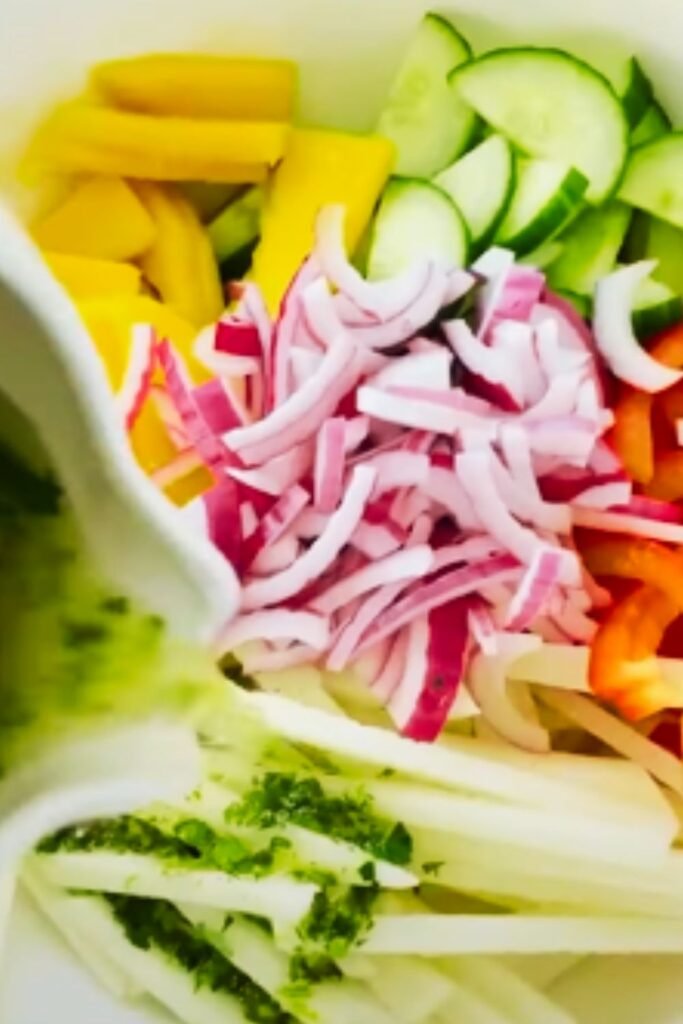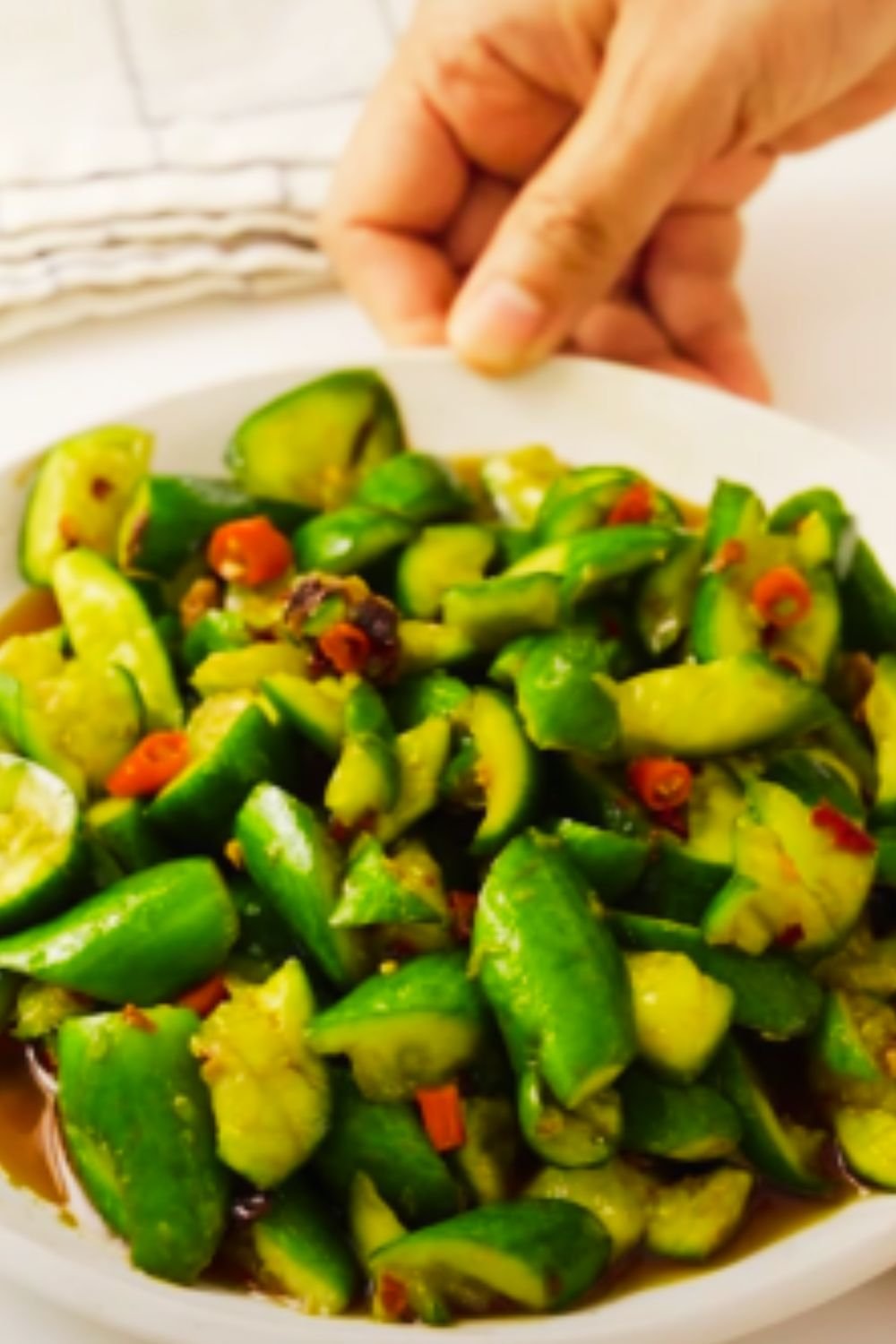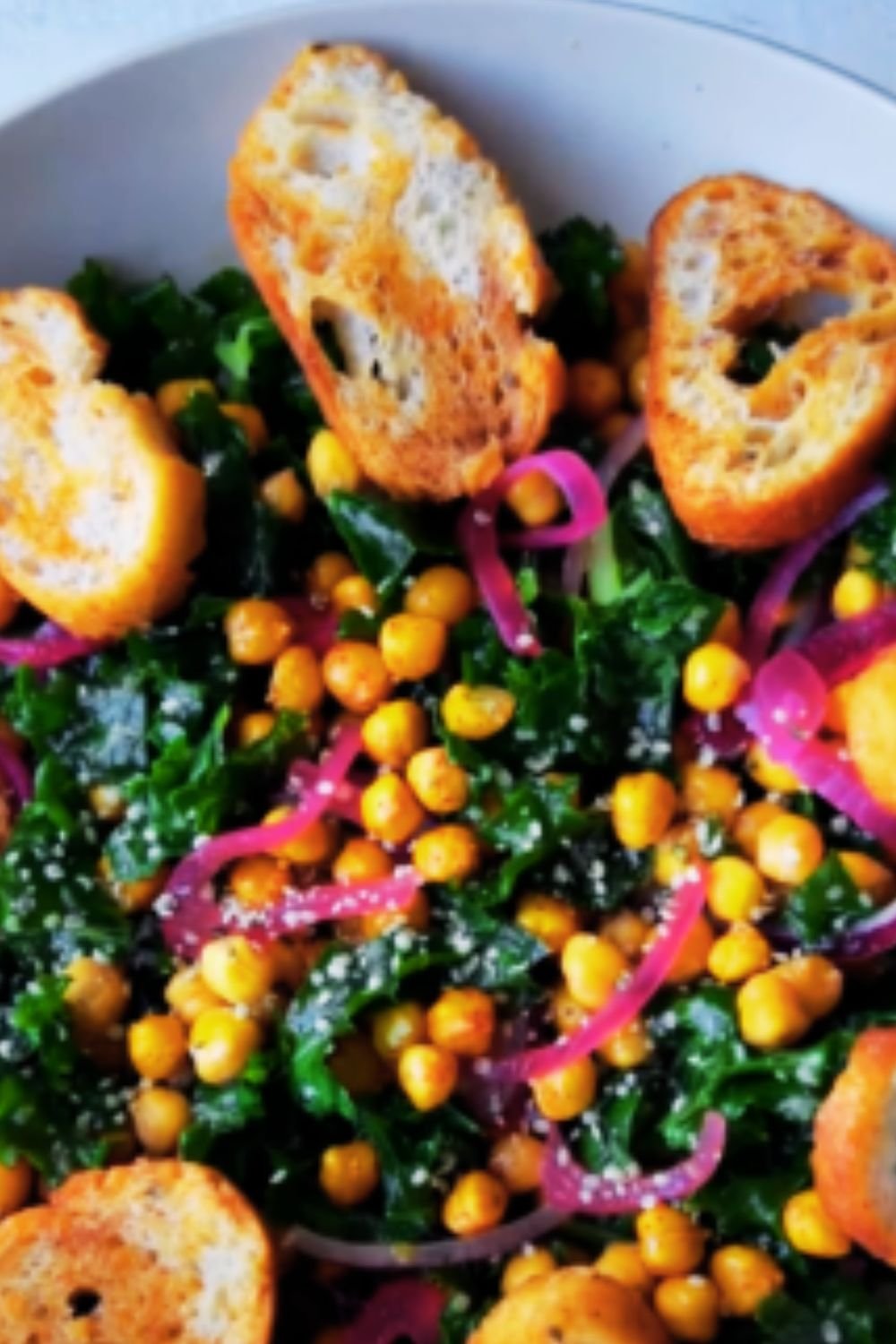Have you ever bitten into something so refreshingly crisp that it actually makes you feel cooler on a sweltering summer day? That’s exactly what happens when you experience the delightful crunch of jicama paired with cool cucumber in this vibrant Chili Lime Jicama and Cucumber Salad. I’ve been making variations of this recipe for years, and it never fails to impress both my family and guests with its perfect balance of heat, tang, and sweetness.
What Makes This Salad Special
Before I dive into the recipe itself, let me tell you why this particular combination works so beautifully. Jicama, often overlooked in American cuisine, is a root vegetable with a crisp, slightly sweet flesh similar to an apple but with a more neutral flavor. When paired with the refreshing coolness of cucumber and kicked up with chili and lime, it creates a symphony of textures and flavors that dance across your palate.
What I love most about this salad is its versatility. It works wonderfully as a side dish for grilled meats, as a topping for tacos, or even as a standalone light lunch on those days when you want something bright and nourishing without weighing you down.
Getting to Know Jicama: The Star Ingredient

Jicama (pronounced HEE-kah-ma) might look intimidating with its brown, papery skin, but beneath that rough exterior lies a world of crisp, juicy goodness. Often called the “Mexican potato” or “Mexican turnip,” this root vegetable deserves a spot in your regular rotation.
Jicama : A large, bulbous root vegetable with a thin brown skin and crisp, white interior that’s juicy and slightly sweet with a texture similar to a crisp apple or water chestnut.
Nutrition Benefits : Low in calories but high in fiber, vitamin C, and potassium. It contains inulin, a prebiotic fiber that feeds beneficial gut bacteria.
Selection Tips : Choose jicama that feels heavy for its size with dry, papery skin free of blemishes or soft spots. Smaller ones (under 4 pounds) tend to be sweeter and less fibrous.
Storage : Unpeeled jicama can be stored in a cool, dry place for up to 2 weeks or refrigerated for up to 3 weeks. Once cut, store in water in an airtight container and use within a week.
The true beauty of jicama lies in its ability to absorb flavors while maintaining its signature crunch. Unlike other vegetables that might wilt or become soggy, jicama stays crisp even after marinating, making it perfect for make-ahead salads and slaws.
Ingredients for Chili Lime Jicama and Cucumber Salad
To create this refreshing masterpiece, you’ll need:
For the Salad:
- 1 medium jicama (about 1.5 pounds), peeled and julienned
- 2 English cucumbers, julienned (leave skin on for color and nutrients)
- 1 red bell pepper, thinly sliced
- 1/2 small red onion, thinly sliced
- 1/4 cup fresh cilantro, chopped (plus extra for garnish)
- 2 tablespoons fresh mint, chopped
- 2 jalapeños, seeded and finely diced (leave seeds in for extra heat if desired)
For the Chili Lime Dressing:
- 1/4 cup fresh lime juice (from about 3-4 limes)
- 2 tablespoons extra virgin olive oil
- 1 tablespoon honey or agave nectar
- 2 teaspoons chili powder
- 1 teaspoon ground cumin
- 1/2 teaspoon smoked paprika
- 1 garlic clove, minced
- 1 teaspoon sea salt
- 1/4 teaspoon freshly ground black pepper
Optional Garnishes:
- 1/4 cup toasted pepitas (pumpkin seeds)
- 1 ripe avocado, diced
- Crumbled cotija cheese
- Extra lime wedges
I’ve tweaked these proportions over time, and I find this combination offers the perfect balance. However, don’t be afraid to adjust according to your preferences – maybe you love cilantro and want to double it, or perhaps you’re sensitive to heat and want to reduce the jalapeño. Make it your own!
Nutrition Breakdown
For those who are nutrition-conscious (like me), here’s a breakdown of what you’re getting in each serving of this nutrient-dense salad:
| Nutrient | Amount per Serving | % Daily Value |
|---|---|---|
| Calories | 120 | – |
| Carbohydrates | 19g | 6% |
| Fiber | 9g | 36% |
| Protein | 2g | 4% |
| Fat | 4.5g | 7% |
| Vitamin C | 45mg | 50% |
| Vitamin A | 1250 IU | 25% |
| Potassium | 450mg | 13% |
| Folate | 65mcg | 16% |
| Calcium | 40mg | 4% |
| Iron | 1.2mg | 7% |
Based on a 2,000 calorie diet. Values are approximate per 1 cup serving without optional garnishes.
What I love about this nutritional profile is how much fiber and vitamin C you get for relatively few calories. The fiber from the jicama and cucumber helps keep you satisfied, while the abundance of vitamins and minerals supports overall health.
Preparation Steps
Now, let’s get into the actual preparation. I promise it’s simpler than you might think!
Preparing the Vegetables
- Start with the jicama: Peel the brown skin completely using a sharp knife or vegetable peeler. Cut the jicama in half, then slice into thin matchsticks (julienne). For uniform pieces, you can use a mandoline slicer with the julienne attachment.
- Prepare the cucumber: If using English cucumbers, there’s no need to peel or seed them. Simply trim the ends and julienne to match the size of your jicama pieces. If using regular cucumbers, you may want to peel them and remove the seeds if they’re large.
- Slice the bell pepper and onion: Remove the core and seeds from the bell pepper, then slice into thin strips. For the red onion, slice as thinly as possible – I like to use a mandoline for this.
- Prepare the jalapeños: Wear gloves if your skin is sensitive. Cut the jalapeños in half lengthwise, remove the seeds and membranes (unless you want extra heat), and dice finely.
- Chop the herbs: Rinse cilantro and mint thoroughly, then pat dry with paper towels before chopping.
Making the Dressing

The dressing is where the magic happens, infusing every bite with zesty, spicy goodness:
- In a small bowl, combine fresh lime juice, olive oil, honey or agave, chili powder, cumin, smoked paprika, minced garlic, salt, and pepper.
- Whisk vigorously until well combined and slightly emulsified. Taste and adjust seasonings as needed – you might want more lime for tanginess or honey for sweetness.
- For a smoother dressing, you can blend the ingredients in a small food processor or blender.
Assembling the Salad
- In a large bowl, combine the jicama, cucumber, bell pepper, red onion, cilantro, mint, and jalapeños.
- Pour the dressing over the vegetables and toss gently to coat everything evenly.
- Let the salad marinate for at least 15 minutes before serving to allow the flavors to meld together. This salad actually improves after sitting for a bit!
- Just before serving, garnish with additional cilantro, toasted pepitas, diced avocado, or cotija cheese if desired.
Make-Ahead Tips and Storage
One of the things I appreciate most about this salad is how well it holds up:
- Prep ahead: You can julienne the jicama and cucumber up to 24 hours in advance. Store them in water in separate airtight containers in the refrigerator to maintain crispness.
- Dress strategically: If making significantly ahead of time, consider storing the dressing separately and combining just before serving. However, unlike lettuce-based salads, this one actually benefits from marinating in the dressing for a few hours.
- Storage duration: Dressed salad will keep well in the refrigerator for up to 3 days. The flavors deepen over time, though the vegetables may release some liquid – just drain it off before serving.
- Freezer warning: Don’t try to freeze this salad! The high water content in both jicama and cucumber means they’ll turn to mush when thawed.
Serving Suggestions

This versatile salad pairs beautifully with a variety of main dishes:
- Serve alongside grilled fish tacos or shrimp skewers for a perfect summer meal
- Use as a cooling side dish with spicy chicken enchiladas
- Top grilled chicken or fish with a generous portion
- Scoop up with tortilla chips as a refreshing alternative to salsa
- Add to grain bowls with quinoa, black beans, and roasted vegetables
- Stuff into pita pockets with hummus for a light lunch
- Serve in lettuce cups for a low-carb appetizer option
- Pack in mason jars for picnics or work lunches
For a complete meal, I love to serve this salad with grilled cilantro-lime chicken and warm corn tortillas. The combination of warm, charred protein with the cool, crisp salad creates a perfect temperature and texture contrast.
Creative Variations
While the basic recipe is fantastic on its own, I’ve experimented with several variations over the years:
Tropical Twist: Add chunks of fresh pineapple or mango for a sweet-tart dimension that pairs beautifully with the chili and lime.
Corn and Black Bean: Fold in 1 cup of cooked black beans and 1 cup of fresh or grilled corn kernels for a more substantial salad with southwestern flair.
Asian-Inspired: Swap the chili-lime dressing for one made with rice vinegar, sesame oil, soy sauce, and ginger. Add edamame and top with toasted sesame seeds.
Mediterranean Style: Use lemon instead of lime in the dressing, add diced tomatoes and cucumbers, and garnish with feta cheese and olives instead of cotija.
Seafood Addition: Top with cooked shrimp or crabmeat for a refreshing seafood salad perfect for hot summer evenings.
Avocado Cream: Blend one of the avocados with a portion of the dressing for a creamy variation that coats the vegetables luxuriously.
Health Benefits Deep Dive
This salad isn’t just delicious – it’s nutritionally impressive as well:
Jicama’s Hidden Powers: Beyond its delightful crunch, jicama contains important antioxidants like vitamin C and flavonoids that help combat oxidative stress. Its high inulin content acts as a prebiotic fiber, feeding the beneficial bacteria in your gut and potentially improving digestive health.
Cucumber’s Cooling Effect: Cucumbers are about 96% water, making them incredibly hydrating. They also contain compounds called cucurbitacins, which have anti-inflammatory and even anti-cancer properties according to some research.
Chili Heat Benefits: The capsaicin in chili powder does more than add heat – it can boost metabolism, reduce appetite, and contains anti-inflammatory compounds.
Lime’s Vitamin Punch: Beyond vitamin C, limes contain flavonoids that may help reduce inflammation and support heart health. The acidity also helps preserve the freshness of the other ingredients.
Healthy Fat Balance: The modest amount of olive oil in the dressing provides heart-healthy monounsaturated fats that actually help your body absorb the fat-soluble vitamins present in the vegetables.
Seasonal Adaptations
While this salad shines brightest in summer when fresh produce is abundant, you can adapt it year-round:
Spring: Add radishes, snap peas, and tender herbs like dill or chervil.
Summer: The classic version shines, perhaps with the addition of fresh summer corn or tomatoes.
Fall: Include diced apples or pears for seasonal sweetness, and maybe a sprinkle of cinnamon in the dressing.
Winter: When fresh produce is scarce, focus on the sturdy jicama and add winter citrus segments like grapefruit or blood orange.
Troubleshooting Common Issues
Even simple recipes can sometimes go awry. Here are solutions to common problems you might encounter:
Problem: Jicama is too tough or woody. Solution: This usually indicates an older jicama. Choose smaller ones and make sure to peel deeply enough to remove all the fibrous skin.
Problem: Salad becomes too watery after sitting. Solution: Salt the cucumber lightly and let it drain in a colander for 15 minutes before adding to the salad. Also, make sure your jicama is well-drained after cutting.
Problem: Dressing separates or isn’t emulsifying properly. Solution: Use a blender or food processor to create a more stable emulsion, or add a tiny bit of mustard (about 1/4 teaspoon) which acts as a natural emulsifier.
Problem: Not enough flavor penetration. Solution: Cut the vegetables slightly smaller or allow more marinating time. For maximum flavor, you can also massage the dressing into the vegetables with your hands (wearing gloves).
Problem: Too spicy! Solution: Add more cucumber or jicama to dilute the heat, or serve with a dollop of sour cream or Greek yogurt to temper the spice.
Equipment Recommendations
While you don’t need fancy equipment to make this salad, a few tools can make preparation easier:
Mandoline Slicer: Creates perfectly even julienne cuts for jicama and cucumber. Just be sure to use the hand guard for safety!
Citrus Juicer: For extracting the maximum juice from limes with minimal effort.
Sharp Chef’s Knife: Essential for safely and efficiently peeling and cutting the jicama.
Large Mixing Bowl: Choose one with plenty of room to toss ingredients without spillage.
Airtight Storage Containers: For storing components separately or keeping leftover salad fresh.
Historical and Cultural Context
Jicama has been cultivated in Mexico and Central America for centuries, where it’s often enjoyed raw with chili powder, lime juice, and salt as a street food snack. The combination of chili and lime with crisp vegetables appears throughout Latin American cuisine, reflecting a culinary tradition that balances heat, acid, and texture masterfully.
In Mexico, similar preparations might be called “ensalada de jícama” or simply “jícama con chile y limón” when served as a snack. By incorporating these ingredients into a more elaborate salad, we’re honoring these flavor traditions while adapting them to contemporary tastes.
Questions and Answers
Q: Can I substitute something else for jicama if I can’t find it?
While nothing perfectly replicates jicama’s unique texture and mild sweetness, water chestnuts are the closest substitute in terms of crunch. Asian pears or crisp apples can work in a pinch, though they’re sweeter. Daikon radish offers a similar crunch but with a spicier flavor profile.
Q: How do I know when a jicama is ripe?
Unlike fruits, jicama doesn’t continue to ripen after harvesting. Look for firm jicama with dry, papery brown skin free of cracks or soft spots. It should feel heavy for its size. Avoid any with green tinges or wrinkled skin, which indicate older jicama that may be dry or fibrous inside.
Q: Is this recipe keto-friendly?
While delicious, this salad isn’t strictly keto-friendly as written, since jicama contains carbohydrates (about 11g net carbs per cup). However, you could reduce the amount of jicama and increase the cucumber for a lower-carb version. Also, substitute the honey in the dressing with a keto-friendly sweetener.
Q: My kids don’t like spicy food. Can I make this milder?
Absolutely! Simply omit the jalapeños and reduce or eliminate the chili powder in the dressing. You can set aside a milder portion for kids and add extra chili to the adults’ portions. The lime and herbs will still provide plenty of flavor without the heat.
Q: How long does it take to prepare this salad from start to finish?
With all ingredients on hand, expect to spend about 25-30 minutes total: 20 minutes for peeling and cutting vegetables, and 5-10 minutes for making the dressing and assembling. Preparation time decreases significantly if you use a mandoline for slicing.
Q: Can this be made in advance for a party?
Yes! This is actually an ideal make-ahead salad. You can prepare it up to 24 hours in advance, and the flavors will continue to develop. Just reserve any optional garnishes like avocado, cheese, or toasted pepitas to add just before serving.
Q: How should I adjust the recipe for a crowd?
The recipe easily scales up for larger gatherings. For a party of 12-15 people, simply triple all ingredients. If preparing a very large batch, consider keeping the dressing separate until about an hour before serving to prevent excess liquid accumulation at the bottom of the bowl.
Q: Is there a shortcut version for busy weeknights?
For a quick version, many grocery stores now sell pre-peeled and cut jicama sticks. You can also use a food processor with a julienne blade to speed up the cutting process. In a real pinch, bagged broccoli slaw can substitute for half the jicama – the texture and flavor will be different, but still delicious with the chili-lime dressing.
Final Thoughts
What I love most about this Chili Lime Jicama and Cucumber Salad is how it introduces many people to jicama for the first time. There’s something special about watching someone’s face light up as they experience that perfect crunch and the explosion of bright, zesty flavors.
This salad represents what I believe good cooking should be – simple ingredients treated with care, balanced flavors that excite the palate, and food that nourishes both body and spirit. Whether you’re preparing it for a quiet family dinner or a lively gathering with friends, I hope this salad brings as much joy to your table as it has to mine over the years.
Remember that recipes are living things, meant to evolve with each cook who makes them. Don’t hesitate to adjust and personalize according to your preferences and what’s available to you. The true measure of a recipe’s success isn’t how precisely you follow the instructions, but how much pleasure it brings to those who enjoy it.


